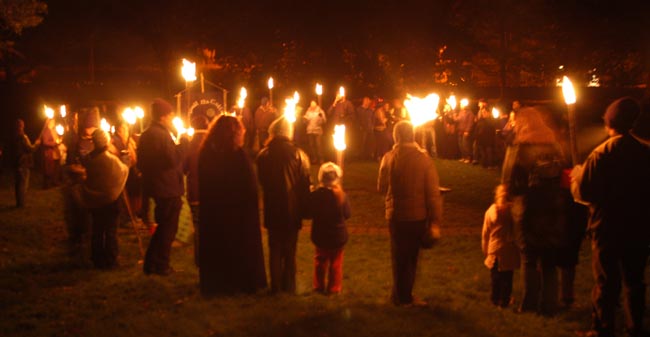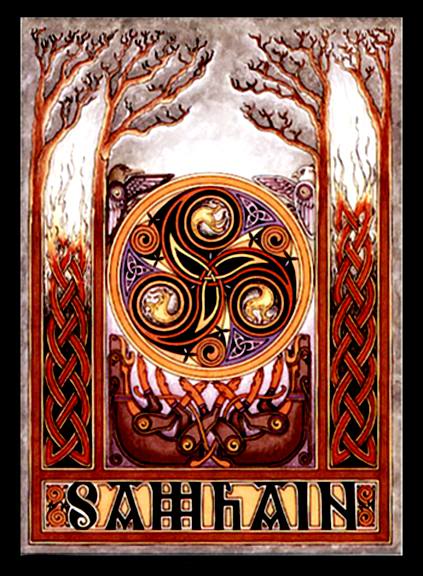Note—Back by popular
demand! It’s the sixth annual appearance
of this holiday classic.
I am
guessing that readers of this blog
are probably more familiar with the origins and development of Halloween than most folks. But for review:
Halloween
traces its origin to the Celtic harvest festival Samhain. It was one of the
four festivals that fell between the Solstices
and Equinoxes and which celebrated
the natural turning of the seasons. Samhain was particularly important because it
was the gate in time to the death and starvation season of winter,
as well a time to celebrate the recent harvest.
This
association with the death of winter also extended to the spirit world, which was considered to be closer to the mortal plane than at any other time of
the year. The Celtic priests—the Druids—marked the occasion with the lighting of bon fires and gifts of food and drink
for the spirits of the dead. Some
consider it also analogous to a New
Year’s Celebration launching a new cycle of the seasons. It was popularly celebrated by the peasantry long after the Druids
passed and well into the Christian
era.
Too
popular to squelch, as with many pagan observances Catholic Church co-opted
the custom as All Saints Day on
November 1. In rural regions especially Samhain customs continued
to be observed on the evening before the Holy
Day—which came to be known as All
Hallows Eve, or Hallowe’en in Scots.
Immigrants from the British Isles
brought some of their customs with them, but Halloween does not seem to have
been widely celebrated colonial America. The Puritans
spent a lot of time trying to squelch other pagan
customs like the May Pole dances associated with the spring Celtic festival of Bealtaine, but for all
of their obsession with witchcraft,
usually associated with those who continued to keep the old pagan traditions,
there is no evidence of suppressing Samhain or Halloween.
In
fact there is little mention of Halloween in American at all until the late
years of the 19th Century when a few
scattered newspapers began reporting
ritual begging on Halloween by masked youths accompanied by general hooliganism, threats, and acts of
vandalism. This was probably introduced by the wave of poor “country” Irish immigrants that
began after the Potato Famine and
continued through most of the rest of the century.
As
it spread, customs for observing the holiday varied regionally. Parties
with games such as bobbing for apples
and the telling of ghost stories
were fairly common. The custom of trick or treating seems to have spread
slowly. What progress it was making was
largely interrupted by the Depression
years when families had little extra
money to spend on treats and by the sugar
rationing of World War II.
In
1947 the popular children’s magazine Jack and Jill published a story on
the custom of Halloween begging and described it in detail, spreading the
practice widely and with amazing uniformity.
By 1951 the practice was wide spread enough that a Philadelphia woman, Mary
Emma Allison and the Reverend Clyde Allison decided to channel the energy to
constructive purposes by introducing Trick
or Treat for UNICEF to support the work of the United Nation’s international children’s work.
By
the mid 1950’s with the strong support of the candy companies and the introduction of cheap masks and pajama style
costumes for children, the practice of trick or treating had become ubiquitous and had even taken on a
feeling of a long standing practice.
| Cheap commercially made costumes and masks spread Trick or Treating through city and suburban Post-War neighborhoods and helped make Halloween a ubiquitous childrens celebration. |
What
started with ghost stories and the like, soon spread to all types of horror, fueled by the growing
popularity of increasingly violent Hollywood
films. Gore became and more and more common theme and showing horror films for the whole month of
October in theaters and on TV was standard by the early 1970’s.
About
the same time the first generations of trick or treaters grew up but continued
to enjoy the dress-up and parties of Halloween.
It is, year by year, an increasingly popular adult holiday, incorporating many of the features of
various world masquerade festivals
with macabre twist.
Halloween
is now the second most widely celebrated
holiday in the United States and
is an economic powerhouse, generating sales second only to Christmas. Popular American
media have spread the customs of trick or treating and celebrating gore around
the world, often supplanting truly ancient celebrations of Halloween in the
Celtic countries.
The
resurgence of Christian Fundamentalism
in the U.S. has led to a counter
movement to strip the “Satanic”
festival from public schools and the
wider community. Although they get it wrong—there was never
any connection between Satanism and
Halloween—the fundies, ironically,
at least recognized a religious tradition hiding under the commercial hoopla.
 |
| Wiccans and other neo-pagans attempt to interpret and resurrect what they believe are ancient Samhain traditions. |
At
the same time re-invented “traditional”
paganism like Wicca, one of the
most rapidly growing religious
movements of the last twenty years, has striven to recapture the nearly lost
significance of the holiday’s roots in Samhain.
Go
thou, and celebrate as thou wouldst.

